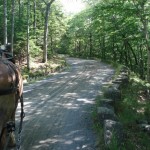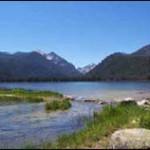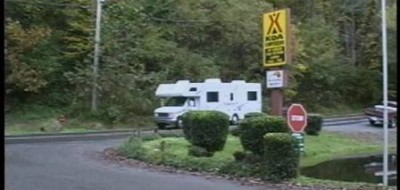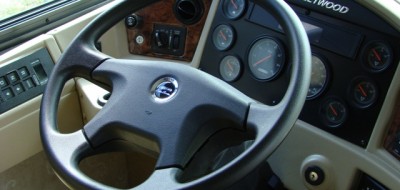By Lynn Difley
Bill writes to me” I have spinal stenosis but that really only bothers me when I stand and walk. The thing that bothers me when I sit and drive a lot is the back end of my butt. It is like all the pressure is on it and it really hurts. Getting up and out and walking around for a while makes it better but once it starts it only takes about another half hour of driving to bring it back again. I have a 5er with a power seat in the truck. I have tried moving the seat forward or back, changing the height, changing the tilt of the seat with no success.
“Any suggestions on what causes this and what I can do about it?”
As I mentioned in an earlier post, back problems plague our society, and those who sit a lot–such as those who drive or ride in an RV, truck or tow vehicle suffer more than many.
There are two major anatomical conditions that result in back pain, the better known is a herniated disc, which is caused by disc material protruding backwards, irritating a nerve root which causes pain to radiate along the back and sciatic nerve. Bill, however, has a lesser-known but very common problem known as spinal stenosis.
Spinal stenosis is a medical condition in which the spinal canal narrows and compresses the spinal cord and nerves. It is often due to spinal degeneration that occurs with aging. Most back problems are caused by one of two conditions, spinal stenosis or herniated disc and they present different scenarios and require slightly different treatments. Arthritis is the most common cause of spinal stenosis, as the cartilage wears away and the fluid that is found in the spinal column begins to dry up. Pressure on the spinal nerves can result in pain in the areas that the nerves supply. It can produce numbness or tingling in the buttocks or legs. Because it is a condition of the narrowing of the spine, leaning forward may relieve the symptoms, whereas upright standing or walking may cause pain. (It is just the opposite with herniated disc problems, which require a leaning backward to decrease the pain and pressure.) There are steps that can be taken to help alleviate the symptoms, although they will not restore the spinal canal to its former healthy condition.
Back exercises that flex the spine (forward bending) may help the passageways open up and allow the irritation or impingement to resolve. In order to alleviate the symptoms, the back muscles that hold the spine in extension need to be stretched and the muscles that bring the spine into flexion (forward bending) are strengthening.
The first stretch is lying on the back, gently pulling the knees into the chest (shown at left). Hold this knee hug position 30 seconds while breathing deeply. Repeat 4 to 5 times.
 Second stretch–child’s pose (shown at right). On all fours, pull the hips back to the heels, with the chest down, arms outstretched. Hold for 30 seconds, slowly return to all fours, repeat 4-5 times.
Second stretch–child’s pose (shown at right). On all fours, pull the hips back to the heels, with the chest down, arms outstretched. Hold for 30 seconds, slowly return to all fours, repeat 4-5 times.
The exercises for strengthening the lower abdominal muscles will help to develop the strength to hold the posterior pelvic tilt, a postural position that lessens the pain.
Lie on the back; press the low back into the floor by tightening the lower belly muscles. Pull the belly button into the body, hold 10 seconds, and repeat 10 times.
 Toe-tap march – Once the last exercise is mastered, come into the pelvic tilt position, hold the abdominal muscles tight and march in place, lifting first one leg then the other from the floor. Work up to marching for 30 seconds, resting for 30 seconds, repeated 3 times. Be sure the hips do not move in this exercise, and do not allow the back to arch or leave the floor, control it by tightening the belly.
Toe-tap march – Once the last exercise is mastered, come into the pelvic tilt position, hold the abdominal muscles tight and march in place, lifting first one leg then the other from the floor. Work up to marching for 30 seconds, resting for 30 seconds, repeated 3 times. Be sure the hips do not move in this exercise, and do not allow the back to arch or leave the floor, control it by tightening the belly.
| Curl ups–lying on the back, fold the arms across the chest, pull the belly button in and up, and lift the head and shoulders from the floor. Hold four seconds, lower slowly work up to two sets of ten curl ups. |  |
These exercises alone will not necessarily heal your back, but will allow you to more easily and naturally hold a pelvic tilt while walking, standing and sitting, which enables you to perform more activities with less pain. Until you achieve greater strength and flexibility, you may have to take frequent breaks from driving to do your stretches and walk around to increase circulation and blood flow to the painful lower back area. It is healthier, for that matter, for everyone–back pain sufferers or not–to take frequent breaks from sitting, to move around, walk, stretch and restore circulation and upright positioning for the spine. Good luck Bill, I hope your back pain resolves itself and you enjoy your travels again.
Check out my book, Good Backs, for more on taking care of your back and for other health and fitness information on my Web site: HealthyRVLifestyle.com






Pingback: bedroom set
Scott Coffman
Stevie-
Please see my earlier reply to Bill.
When my GP called to tell me my MRI results – which indicated a ruptured disc AND spinal stenosis at the same position – she asked me [again] if I had numbness or tingling in my ‘private parts’. That was not the case but her warning was: if that happened between the couple days between diagnosis and the surgery I was to go to the emergency room immediately. I don’t recall the medical terminology she used, all I remember is the urgency she conveyed in the message.
I’ll repeat what I said to Bill. Spinal stenosis is NOT curable by exercise or physical therapy. The spinal column will continue to thicken and squeeze the nerve (with or without the complication of a disc issue) causing horrendous pain through the hips and down the legs. Talk to your doctor. See about getting a referral to a GOOD neurosurgeon. From my experience the surgery is well worth it. I have NO pain other than some minor aching at the surgical site itself which will settle with time.
Good luck to you too!
Sue Coffman
Scott Coffman
Oh Bill!
I feel your pain!
The first thing you need to understand is that spinal stenosis can NOT be cured by any amount of exercise or physical therapy (I tried both). It is a thickening of the spinal bone.
In early July an MRI determined that I had a ruptured disc at the same location of spinal stenosis – L4-L5. What lead up to the MRI was excruciating pain in my hips, down my legs and numbness in my feet and toes. I was referred by my GP to a neurosurgeon who had me in day surgery (yes! day surgery – in and out in two hours!) within the week. That was done on July 17th. I was allowed to drive in one week, and had lifting, bending and twisting restrictions for a minimum of 6 weeks. As of today, I’m back to work 1/2 time, next week back to work full time.
Now, you need to understand that ‘day surgery’ makes it sound like this is a piece of cake. Not exactly. There were some very sharp hip pains as the spinal nerve finally had some room. That lasted about 3 weeks. But having said that, today I can tell you that I have full use of my legs, feet and toes WITH NO PAIN! The surgical site is a bit sensitive but time will cure that. From my experience, I’d rather have the surgery than deal with the pain I had before. And I’m not kidding. My husband and I walk together now and he tells me to slow down!
The bottom line is: you can’t ignore this. It won’t get better on its own. You have thickening of the bone. Only surgery will cure that. I don’t promise that this will cure your butt issue but I’d bet it goes a long way to improve it! And – at the very least – you’ll be able to stand and walk again!
I hope you have good insurance…… Good luck!
Sue Coffman
Stevie Duvaldadrian
I TAKE IT THAT THESE ARE THE EXERCISES TO HELP SPINAL STENOSIS. I AM EXPERIENCING PAIN IN THE INNER THIGH AREA OF MY RIGHT LEG THAT SHOOTS UP INTO THE GROIN AREA. THIS PAIN SEEMS TO BE ALLEVIATED WHEN I LEAN BACK OR WALK IN A RIDICULOUSLY UPRIGHT POSITION ( MY HUSBAND CALLS IT MY ” IMPORTANT PERSON POSTURE “). AFTER A WHILE HOWEVER, THIS CAUSES MY BACK TO HURT. THE OTHER SOLUTION SEEMS TO BE JUST SITTING FOR ABOUT 5 MINUTES. I’VE NOTICED THAT THIS IS BROUGHT ON MORE QUICKLY BY CLIMBING STAIRS OR BY WALKING UP HILL, ALTHOUGH IT STILL STARTS AFTER ABOUT A BLOCK OF WALKING ON A FLAT SURFACE AS WELL. HAVE YOU EVER HEARD OF ANYONE ELSE WITH THESE SYMPTOMS? I DO HAVE A VERY SLIGHT HERNIATED DISC SO WOULD THESE EXERCISES ALSO HELP ME?
Lori Sherman
Though I recognize that there are medical issues which impact your back and may require surgery, I personally have tried a more holistic approach to back pain and headaches.
Everything we do in daily living, (e.g., walking, standing, sitting, reaching, bending, twisting, lifting, you get the point) impacts our spine. Pain is pressure on the nerves. Sometimes exercise or a spinal adjustment can relieve that pressure. I have found that a GOOD chiropractor maintenance program (approximately once a quarter) helps my back tremendously. I have also found that a GOOD massage also relaxes the muscles, tendons, and ligaments and minimizes my need for adjustments.
Try it! You might like it.